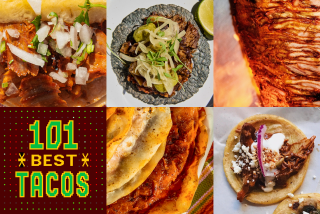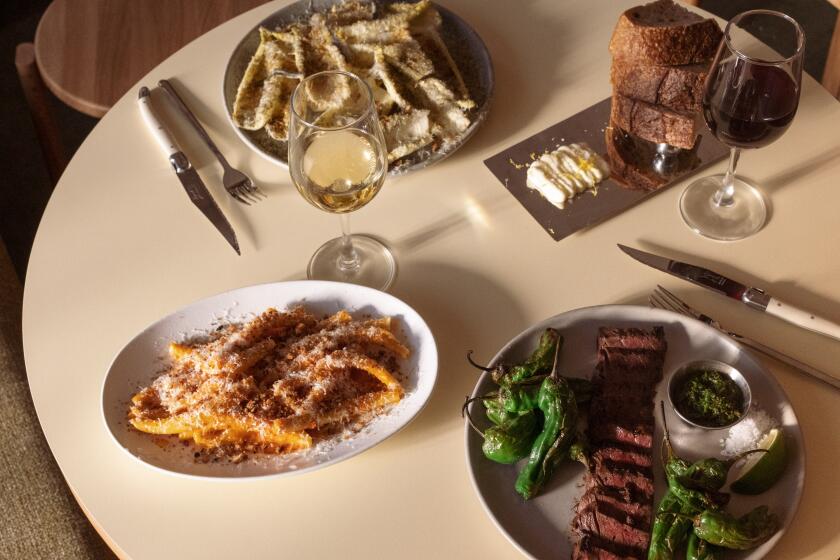Legacy In a Can
I can’t remember the precise occasion. it could have been a family reunion or it could have been a funeral. In my family both are reasons to eat well--like the Hassids who dance for joy and for grief. I do know it was in Santa Barbara because we stayed at my Uncle Harry’s and Aunt Terry’s, and I know it was family because I was asked to bring my mother’s chiles rellenos. When she’d died a few years earlier, the mourning within my extended family seemed considerably eased by the knowledge that the recipe had been handed down.
I brought six dozen chiles rellenos and stretched them by serving each chile with hefty portions of rice and beans. No a la carte, especially on seconds. I heard squabbles in line and allegations of rice-and-bean dumping. The chiles quickly disappeared, except for the dozen I had held out for my Aunt Terry. She hid them when we got back to the house because my older brother Ernie was also staying the night, parked in a camper in the driveway, and she knew that Ernie had no conscience when it came to chiles rellenos.
Ernie had carefully monitored that afternoon’s chile distribution and he knew some had survived. Around midnight we all heard the refrigerator door open and a long pause followed by the crinkling of aluminum foil and the clink of casserole lids. Cupboard doors, drawers and closets were opened and slammed shut. The front door banged and then the door to the camper slammed and everyone went back to sleep. My aunt had hidden the chiles in an ice chest in the trunk of her car. She kept them locked there until Ernie was on his way back to San Francisco.
These chiles will wake you at midnight, craving more. The family line on them is, “Here, kid. The first one’s free. It’ll make you feel real good.” Leftovers are unlikely, but if they do survive, they are one of the world’s great breakfasts. They have nothing to do with the traditional restaurant chiles rellenos--roasted fresh chiles with their frothy egg batter and freshly made tomato sauce, or muy authentico stuffed poblanos with picadillo. This is a 1930s recipe, one of those bastardized and fortunate combinations created because the authentic ingredients (fresh Anaheim or poblano chiles) weren’t always available. Or perhaps because canned ingredients may have been considered “classier” than the fresh.
I call this my mother’s chile relleno recipe, but she credits a high school friend named Lucy Carriedo. It may also be from Elena Villasenor, who was my brother Tony’s godmother, or that of my great aunt, Dorothy Renteria. I’ve found many variations in the cooking notebooks I inherited from my mother and grandmother. Wherever the recipe originated, I now think of it as a “historical imperative,” like New York pizza or chop suey--inauthentic but addictive and great cold for breakfast.
Marjorie’s Chiles Rellenos
Makes 48 chiles rellenos
2 27-ounce cans whole green chiles, roasted and peeled
2 pounds Monterey Jack Cheese
3 8-ounce cans tomato sauce
3 cups vegetable oil
Batter
2 cups flour
13/4 cups milk
4 eggs, beaten
1 medium onion, grated
*
Drain chiles. Cut 48 triangular-shaped wedges of cheese. Insert cheese wedges into chiles. To mix batter, first whip eggs, then add onion and flour. Mix and gradually add milk. Consistency should be thin.
Pour 1 cup oil in large fry pan and heat until nearly smoking. Pour batter into wide bowl (salad bowl is ideal). Dip stuffed chiles in batter, turn and coat thoroughly and drop into hot oil, three or four to a pan. Repeat, adding remaining oil as necessary, until all chiles are cooked.
By the time you fill the last pan, the first chiles will probably be ready to turn. Brown both sides to golden, then drain on paper towels and place on lightly oiled cookie sheets. Preheat oven to 300 degrees. Lightly cover chiles with tomato sauce and bake for 30 minutes.
More to Read
Eat your way across L.A.
Get our weekly Tasting Notes newsletter for reviews, news and more.
You may occasionally receive promotional content from the Los Angeles Times.










